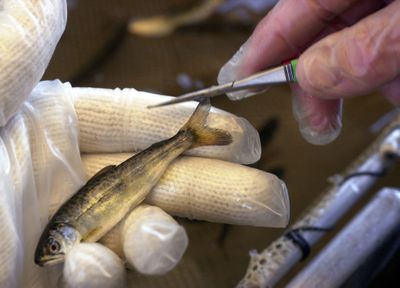Appeals court upholds salmon hatchery policy

GRANTS PASS, Ore. – A federal appeals court Monday upheld the federal government’s discretion to use salmon raised in hatcheries to bolster wild runs, but not as a substitute that would lift Endangered Species Act protections.
The ruling Monday by a three-judge panel of the 9th U.S. Circuit Court of Appeals in San Francisco included the last of a series of lawsuits on behalf of a coalition of builders, farmers and property rights advocates to remove restrictions on development and agriculture that protect salmon.
It also covered a challenge by conservation groups to a decision by National Oceanic and Atmospheric Administration (NOAA) Fisheries to downgrade protections for steelhead in the upper Columbia River from endangered to threatened.
“We are satisfied that the Hatchery Listing Policy is consistent with both the plain language of the (Endangered Species Act) and with the statutory goal of preserving natural populations,” Judge Diarmuid F. O’Scannlain wrote in the opinion. “We are also convinced the decision was based on the best scientific evidence available.”
The high water mark for the Pacific Legal Foundation, a property rights public interest law firm representing the coalition, was a 2001 ruling by U.S. District Judge Michael Hogan in Eugene that tossed out threatened species protection for the Oregon coastal coho because hatchery fish were not listed along with wild fish, when they were considered part of the same population group.
NOAA Fisheries came up with a new policy, which allows for hatchery fish to be used to bolster dwindling populations of wild fish, but does not count them equally with protected wild fish. If there are surplus hatchery fish, they can be harvested, even when wild fish must be put back unharmed.
Studies have concluded that fish raised in hatcheries do not survive in the wild as well as fish spawned in the wild. While the fish may be genetically similar, the wild fish have behavioral differences that make them more successful.
“This was the single most important legal case we were faced with under the Endangered Species Act,” NOAA Fisheries spokesman Brian Gorman said from Seattle.
“Unlike, say, the hydropower issues we are wrestling with in the Pacific Northwest, this hatchery issue affected virtually every single listing in the country for salmon,” he added. “This means that questions over whether or not we can get on with things that move toward recovery have been answered.”
Pacific Legal Foundation lawyer Damien Schiff said from Sacramento, Calif., that there remained a possibility they could ask the full appeals court to reconsider the cases, and future lawsuits could be brought attacking the issue from a different angle.
But efforts to expand the Oregon coastal coho ruling to other salmon species by arguing hatchery fish can be counted along with wild salmon, “are probably not going to get anywhere in the future,” he added.
Jan Hasselman, a lawyer for Earthjustice, which represented the conservation groups, said the good news was that the appeals court recognized that the objective of the Endangered Species Act was to restore wild salmon, not just replace them with fish raised in hatcheries.
“The building industry and Pacific Legal Foundation have engaged in a 10-year effort to reduce protections for wild salmon based on numbers of hatchery fish,” he said from Seattle. “That effort is conclusively a failure. The people that supported it within the government are gone. It has been rejected across the board by numerous courts. And wild salmon remain protected. Let’s move on to restoring their habitat and put this chapter behind us.”
The ruling stemmed from two cases.
One involved a decision by NOAA Fisheries to downgrade protection for Upper Columbia River steelhead from endangered to threatened because hatchery stocks were helping to restore the wild population. Conservation groups sued, and U.S. District Judge John C. Coughenour in Seattle agreed with them.
In the other, Pacific Legal Foundation sued on behalf of the building industry, farm and property rights groups to undo the listings of 16 West Coast salmon and steelhead populations, arguing that abundant hatchery fish made it unnecessary to protect the wild ones, or to impose restrictions on development and agriculture to maintain habitat.